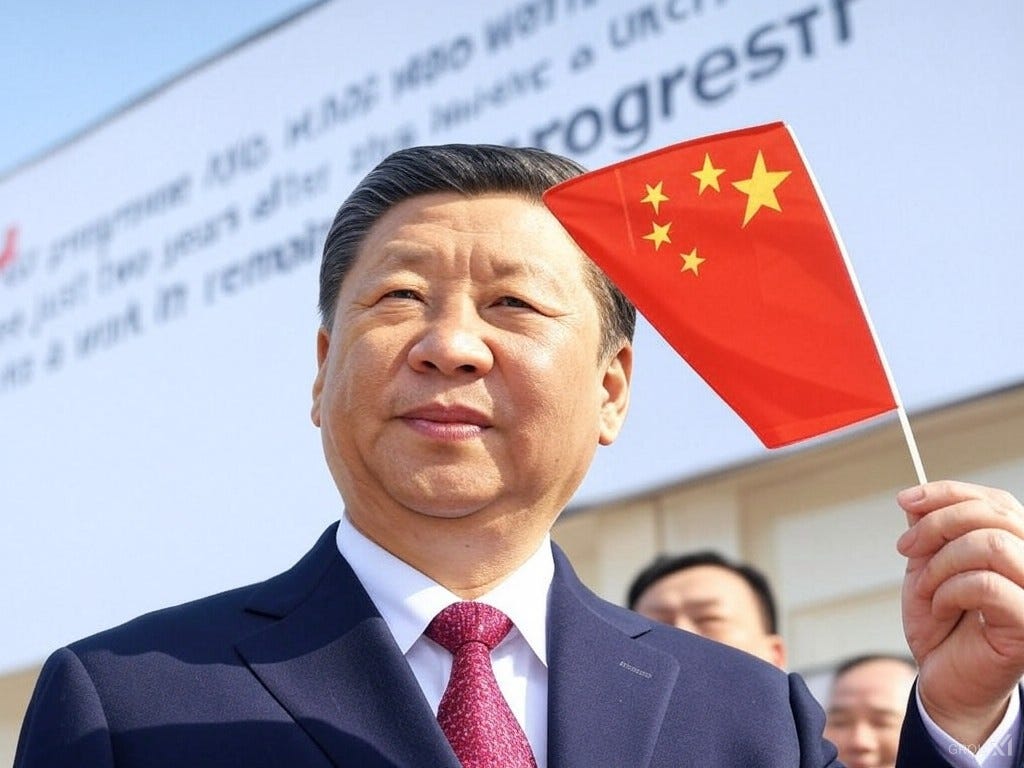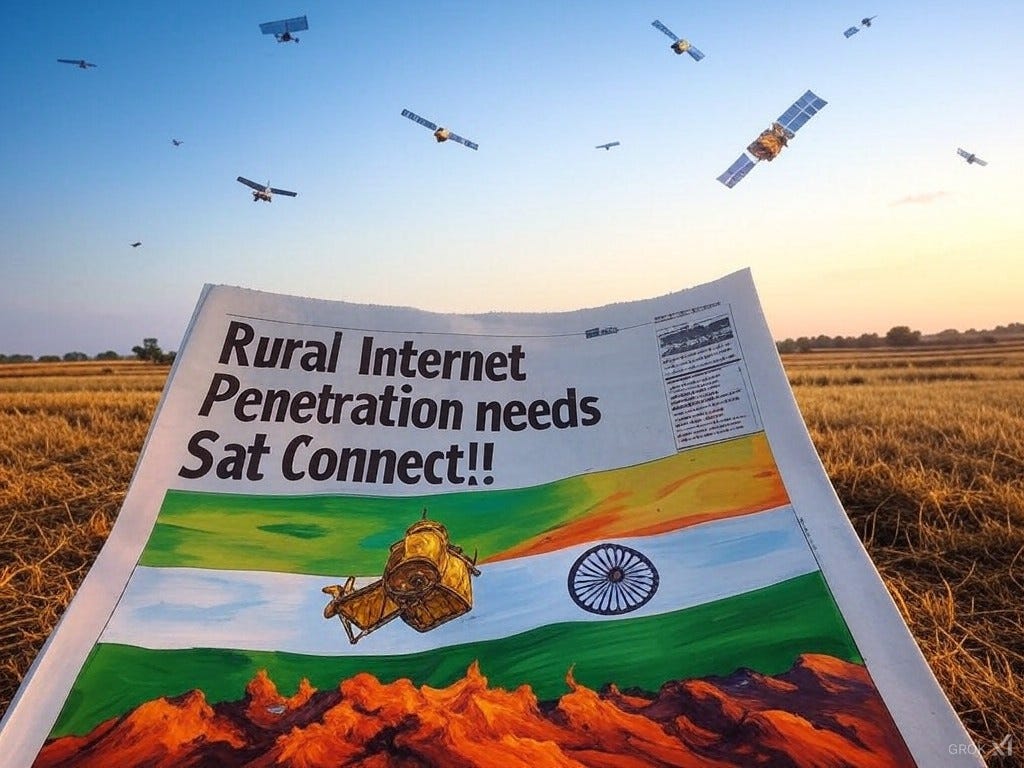#5: Rise & Impact of India's Rural Internet Penetration - And what's needed now!
According to the Internet and Mobile Association of India (IAMAI), by 2023-end, rural India accounted for 50% of internet users, up from 35% in 2015.
According to the Internet and Mobile Association of India (IAMAI), by 2023-end, rural India accounted for 50% of internet users, up from 35% in 2015.
And by 2025, it will also account for 56% of all new to internet users in India.
Did you know that?
Well, this surge in rural internet users has not only democratised access to information but also sparked a cultural shift, with a 150% increase in digital content consumption in regional languages like Hindi, Telugu, and Tamil, according to a report by the Media and Entertainment Skill Council.
Thus, today, we explore how over 60 crore rural Indians are now connected to the Internet, how we got there, and, most importantly, what more we need to do.
..
See, the quest to connect rural India with the digital world began in earnest in the early 2000s.
The first significant effort was the establishment of the Common Service Centers (CSCs) in 2006, part of the National e-Governance Plan.
What was that? The primary thing to know is that this programme aimed to provide digital government services to even the most remote villages.
This novel approach used existing physical infrastructure in schools, panchayat offices, and other places to bridge the digital divide. The intent was to use vacant spaces to build CSCs, which would increase the penetration of the Government’s schemes and policies through the Internet.
This has made a resounding impact, with over 4 lakh CSCs operational, providing services ranging from banking to telemedicine and an average of 30 lakh daily transactions, according to CSC e-Governance Services India Limited.
But, but, but - Wait a second.
See, to make this happen, just physical infra would never be enough. Internet infrastructure was also a major missing piece.
Thus, after the Government had caught the low-hanging fruit, the real work began in 2011 with the BharatNet project.
Many often misunderstand this to be just about laying cables. But, frankly, the bigger picture is that this was about fostering an ecosystem that would provide broadband connectivity to all 2.5 lakh Gram Panchayats (village councils) in India.
And, under the program, over 4.5 lakh kilometres of optical fibre had been laid by 2023, creating a robust network that supports high-speed internet for services like telehealth, e-education, and e-governance in rural areas in over 1.9 lakh Gram Panchayats.
Plans are to extend this to every village by 2025. And overall, this is estimated to have involved an investment of a massive Rs 42k crore.
It has also spurred job creation, with over a lakh direct and indirect jobs created in related sectors like fibre maintenance and digital service provision.
It has also facilitated many small success stories. For instance, advanced applications of IoT-based farming solutions, like in Rajasthan, where intelligent irrigation systems have increased crop yield by up to 20% for participating farmers, according to a study by the Indian Agricultural Research Institute.
As small and nascent this success may be, it would have been impossible without BharatNet.
Of course, the introduction of the Government’s Digital India initiative in 2015 strengthened the efforts significantly.
This ambitious program aimed to transform India into a digitally empowered society, with a special focus on digital literacy. To this end, the Government launched a specific program, Pradhan Mantri Gramin Digital Saksharta Abhiyan (PMGDISHA), which is rarely discussed.
The programme aimed to make six crore rural households digitally literate by 2025. According to the last available public data, the number of people trained directly under the programme reached 60 lakh by 2022, each representing a household.
The best part? Over 25 lakh of these were women! According to a survey by the Centre for the Study of Developing Societies (CSDS), women now conduct over 30% of digital transactions in rural areas.
That’s a huge impact!
..
Meanwhile, any of this is futile if it doesn’t acknowledge the role played by Mukesh Ambani and his Jio.
Launched in 2016, Jio's strategy of offering low-cost data plans was instrumental in bringing the Internet to the very core of rural India.
It immediately reduced the cost of 4G data by a whopping 98%!
That was the lowest cost of data anywhere globally, and even after multiple upward tariff revisions in the last few years, tariffs for 4G and 5G data in India remain dirt cheap compared to the global standards and the rates that were standard in India back in 2015.
This, coupled with Jio’s introduction of affordable 4G and 5G features/smartphones, has also significantly fuelled internet adoption. According to the Telecom Regulatory Authority of India (TRAI), data consumption per user in rural India has jumped from 3.2 GB per month in 2016 to 12 GB by 2023, a growth of 275%.
Thus, it is no wonder that Jio today holds an almost 40% market share of the Indian telecom market, even though it offers no 2G services, which accounts for a large portion of Airtel’s and an even more significant portion of Vi’s subscribers.
Of course, the state-owned Bharat Sanchar Nigam Limited (BSNL), the telecom operator, has also been crucial in less commercially viable rural areas.
And overall, the impact of all of this on the broader economy has been profound.
As aforementioned, by 2023, rural internet users contributed to 56% of new internet subscribers in India, significantly driving digital economy growth.
This digital influx significantly altered market dynamics, as according to Nielsen India, rural consumers now account for 35% of the online FMCG market, up from just 10% in 2015.
This significant impact can be validated by the fact that, according to the Union Government’s Economic Survey last year, rural e-commerce saw a 300% growth in transaction volume from 2019 to 2023, primarily led by platforms like Meesho.
In addition, according to market research by TechSci Research, the rural digital market is projected to grow at a CAGR of 25% from 2023 to 2028. This influence has extended to local entrepreneurship, with rural startups leveraging low-cost data to innovate.
A case in point is the startup Gramophone, which provides farmers with real-time agricultural advice. Since its inception in 2016, its user base has grown by 400%.
..
That said, patchy internet connectivity remains a problem in much of rural India even today.
Compare that to China, which, as expected of it, launched the 'Village Connected' project in 2004 and achieved high-speed, reliable internet connectivity to 98% of its villages within just a decade.
Our programme was launched just two years after China’s and remains a work in progress.
The biggest challenge here, apart from the well-known elephant-like pace at which India is sadly known to execute much of such national-scale projects, is the lack of ancillary infra, with electricity being a significant barrier.
Power outages are common and affect internet service reliability.
And, attaching generators to telecom towers in these low-density and low-affordability regions is also often unviable.
Another challenge is the cost of devices. Despite initiatives like JioPhone, smartphone affordability remains a barrier. In 2024, the average cost of a basic smartphone was still around Rs 5-6k, a significant amount in rural economies where many survive on daily wages.
And guess what?
According to the National Sample Survey Office’s data for 2023, despite progress, 45% of rural households still lack internet access, primarily due to infrastructure and device affordability.
..
Geopolitically, India's rural digital push aligns with global trends of reducing digital disparities.
This was especially highlighted during crises like the COVID-19 pandemic when internet access became crucial for remote education, telemedicine, and digital commerce.
India's model of using existing infrastructure, such as schools and libraries, as internet access points has been adopted in various forms worldwide, from community networks in Africa to mobile libraries in Latin America.
But now, those nations have begun to pull ahead of India by actively deploying Elon Musk’s Starlink-led satellite internet services, which bypass all traditional infra challenges.
And here, India remains mired in regulations, with things being stuck for over a year and a half now.
There is hope that we could soon see OneWeb and Starlink launch services in India, with Jio and BSNL also competing in partnership with other foreign players.
It remains to be seen when that will happen. However, there is hope that the wait won’t be long. The delay in adopting satellite internet like Starlink could widen the digital divide further, putting India's rural areas at risk of falling behind in global digital advancements.
The World Bank has also emphasised this over the last year.
..
See, the narrative of rural internet access in India is one of ambition, adaptation, and continuous learning.
From the early days of limited connectivity to the current landscape, where digital inclusion is a national priority, this journey reflects technological advancement and a commitment to equitable growth.
However, as we move forward, the story of rural India's digital transformation must keep pace with the global strategies for digital inclusion.
And that needs accelerated adoption of new-age technology, policies and partnerships.
And the India story and its potential deserves that action!
Best,
Jayant, building Biz News+
Sharing non-trending insights from the world of business & economy with ~28k investors on WhatsApp and ~82k readers on LinkedIn daily
And building Deepdives with Jay and Decoding the Dragon newsletters read by ~2.8k and ~3.3k subscribers











